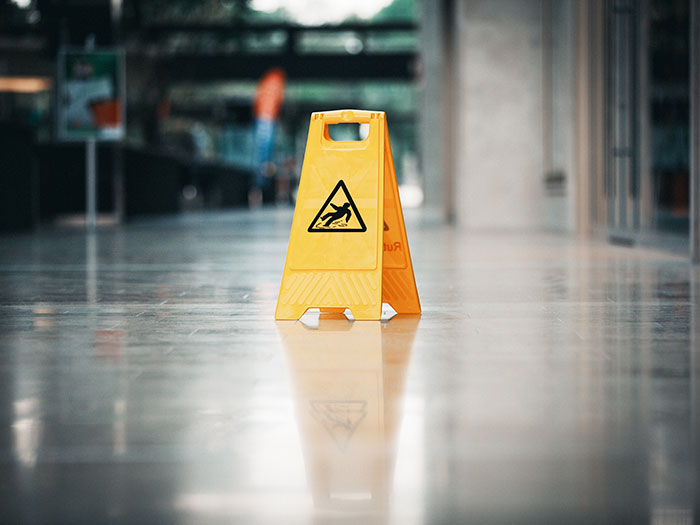Sponsored Content by CNA
The Slippery Exposure that Eludes Safety Managers

If your building has a parking lot, a common entryway, or any uncarpeted floors, you have a significant slip and fall risk.
According to CNA’s data covering a 7-year period, slips and falls account for 36% of claims in their top five industries. With an average cost of $30,000, general liability claims from slips and falls can put a big dent in a company’s bottom line over time*.
And those are the claims that do not involve serious consequences like traumatic brain injuries (TBI). Though infrequent, claims involving a TBI can reach almost $300,000.
”Office and retail spaces are not immune to the slip and fall risk,” said Steve Hernandez, Senior Vice President, Commercial Risk Control, CNA. “From both the frequency and severity standpoint, safety managers for these types of facilities aren’t always aware of the extent of their slip and fall exposure.”
In 2010, CNA noticed an uptick in their general liability claims involving slips and falls. They found that most were the result of walkway surfaces just inside the main entryway of commercial buildings. In 2017, after a two-year investigation, a team of walkway specialists found half of the locations they surveyed failed to meet the minimum threshold for slip resistance set by the American National Standards Institute.
Their study illuminated what safety managers were doing wrong when it comes to measuring slip resistance, floor maintenance, and risk awareness in order to prevent and minimize the damage from falls.
The Source of Slips

Steve Hernandez
Senior Vice President, Commercial Risk Control, CNA
In many cases, safety managers at Class A, LEED-certified buildings — which had seen the biggest spikes in slip and fall liability claims within CNA’s portfolio— thought they were following proper protocols. But their risk mitigation efforts were missing the mark, sometimes even worsening the hazard.
Class A properties like those utilized by real estate companies and financial institutions are at increased risk due to the types of flooring they feature.
“Think of those beautiful, shiny marble or terrazzo floors,” said Shari Falkenburg, Assistant Vice President, Risk Control, CNA. “They are pristine by design. To maintain LEED certification, cleaning crews have to maintain them, but improper cleaning can make floors more slippery.”
Different floor types require different cleaning solutions. That terrazzo, for example, calls for a cleaner with neutral pH and thorough rinsing. The acid-based solutions used for ceramic and porcelain would damage it. Proper cleaning also requires careful management of mops and buckets.
Using the same mop bucket to clean multiple surface types can lead to cross-contamination of debris and leave a soapy residue behind, leaving floors more slippery than before they were cleaned.
“Even the way you store a mop matters,” Hernandez said. “The handle end should point down. Keeping the mop end on the floor means it’s always in contact with debris and won’t clear away contaminants as effectively.”
Facilities also commonly use entryway mats to help absorb the moisture and dirt that pedestrians track in. But like cleaning solutions, a mismatched or improperly used mat can heighten fall risk.
A mat that’s too short, for example, may not collect enough of that moisture and debris. It could also introduce a new tripping hazard if it’s fraying or curling at the edges.
“One building was using a rectangular mat in a circular entryway, and people were actually stepping around the mat when they came through the door. So in some cases a custom-sized mat may be necessary to do the job it’s intended for,” Hernandez said.
The CNA Risk control team helped several real estate companies and bank branches they surveyed to implement specific changes in their floor maintenance. In addition, the team widened the customer’s knowledge about contracts with their property managers and cleaning crew. As a result, the average cost of a fall general liability claim fell to about $10,000 — a 66 percent decrease.
More than the Floor: Full Exposure Expertise
Targeted, site-specific prevention recommendations demonstrate why risk managers should consult safety experts. By bringing extra engineering resources and industry expertise to bear, risk control specialists can help facility managers gain a more detailed picture of their exposure and identify innovative ways to mitigate it.
CNA’s slip and fall study team, for example, evaluated floor slipperiness using the science of tribometry – a technical way to measure slip resistance while walking by determining the dynamic coefficient of friction (DCOF). Using a Binary Output Tribometer (BOT 3000E), they could score each floor DCOF and compare it against industry standard ANSI A326.3. Any score above 0.42 is considered a passing grade.
“But reducing the frequency of falls is not just about the traction of the walking surface. It’s also about visual acuity — something else a facility manager might not think about.” Falkenburg said. “We apply the science of syntonics, which has been used in optometry for a few years. Basically, we’re using light to direct line of sight and wake up the body’s internal sensors – the ability to focus and balance.”
Changing the lighting can reduce excessive glare and help to brighten colors. Creating more contrast helps people more easily register changes in flooring condition or elevation.
“By taking a scientific approach and comparing the results against industry benchmarks, we can take definitive and proven steps to reduce physical hazards,” she said.
A Strategic & Trusted Risk Advisor
CNA’s team of risk control experts meets with clients on a regular basis across the U.S. to help implement these tools and more. Along with sector-specific expertise in fields like construction, manufacturing, technology, financial institutions and healthcare, they also have an understanding of insurance coverages including property, general liability, product liability, and workers’ compensation. Many have achieved their professional designations including the Certified Safety Professional (CSP), Certified Professional Ergonomist (CPE) and Associate in Risk Management (ARM). CNA risk control experts also hold the unique professional credential of UL RRE (Registered Risk Engineer).
“Our segment knowledge compliments our expertise in the lines of business we cover, so we really bring a depth of experience, insight and the ability to benchmark our best practices to our customers,” Falkenburg said.
“Our engagement with insureds starts with a conversation about the nature of their business, including operating priorities and the strategies put in place to mitigate risk,” Hernandez said.
“The purpose of risk control is to assess the level of risk for underwriting purposes, but it often leads to a discussion on the creation of recommendations to strengthen control mechanisms.”
“We are committed to bringing value to our insureds through specific consulting services built for specific segments,” Hernandez said. CNA provides ongoing support in the form of hundreds of online educational opportunities through its School of Risk Control Excellence (SORCE®), which offers courses across a range of risk management topics. And risk control consultants are always at the ready to meet with a company to address a specific need and/or a strategic risk management objective.
“We frequently receive calls from insureds asking us for input on a new product or facility, or a potential change in their processes,” Hernandez said.
“And that really is our goal; to be a strategic and trusted risk advisor for our policyholders and an extension of their risk management team.”
Learn more about CNA’s Slip and Fall Study Report.
* CNA’s Slip and Fall Study Report
This article was produced by the R&I Brand Studio, a unit of the advertising department of Risk & Insurance, in collaboration with CNA. The editorial staff of Risk & Insurance had no role in its preparation.










